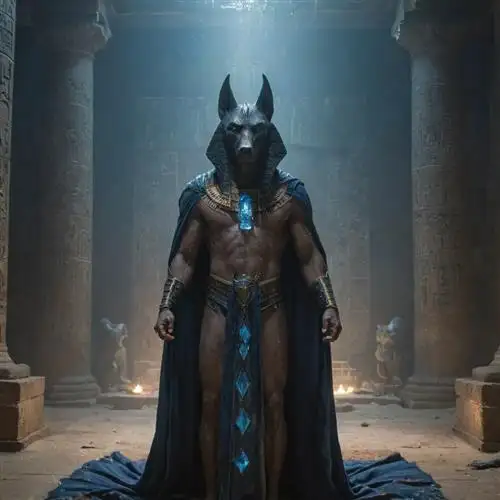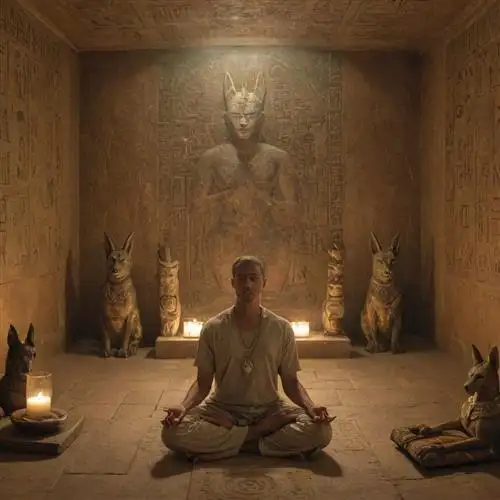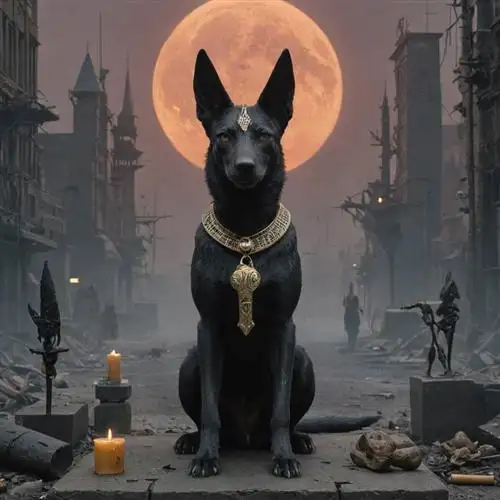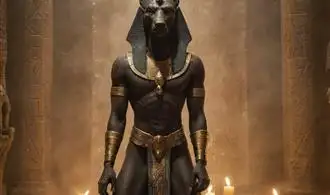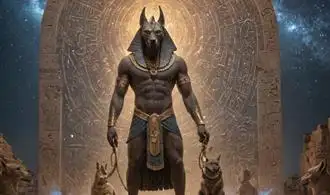
Understanding the Mythology of Anubis
Anubis, the enigmatic and powerful ancient Egyptian deity, has captivated the minds of scholars and spiritual seekers alike for centuries. This enigmatic figure, often depicted with the head of a jackal, is deeply rooted in the rich tapestry of Egyptian mythology, and understanding his mythos is crucial for those seeking to connect with this divine entity. In the realm of Egyptian mythology, Anubis is revered as the god of the dead, the protector of the deceased, and the guardian of the underworld. His role in the afterlife was paramount, as he was believed to be responsible for the crucial process of mummification, ensuring the safe passage of the soul into the afterworld.
Anubis's origins can be traced back to the earliest periods of ancient Egyptian civilization, where he was worshipped as a deity associated with embalming and the protection of the dead. Over time, his role expanded to encompass a broader range of responsibilities, including the weighing of the heart during the Judgment of the Dead, a pivotal moment in the Egyptian concept of the afterlife. It is believed that Anubis's association with the jackal or wild dog was a reflection of his role as a guardian of the necropolis, as these animals were often seen prowling around cemeteries and burial sites.
One of the most fascinating aspects of Anubis's mythology is his relationship with other deities within the Egyptian pantheon. He is often depicted alongside Osiris, the god of the underworld, and was believed to work in tandem with him to ensure the proper transition of the deceased into the afterlife. Additionally, Anubis is sometimes associated with the goddess Nephthys, who was believed to be the mother of Anubis, further emphasizing his connection to the realm of the dead.
Symbols and Iconography of the Anubis Deity
Anubis, the jackal-headed deity of ancient Egyptian mythology, has long been a figure of fascination and reverence. As the god associated with mummification and the afterlife, Anubis' symbols and iconography hold profound significance for those seeking to connect with this powerful entity. From his distinctive headpiece to the sacred objects he is often depicted with, each element of Anubis' visual representation carries a deeper meaning that provides insight into his role and influence.
The jackal head of Anubis is perhaps his most recognizable feature, symbolizing his association with the canine species and their keen senses, which were believed to aid the dead in their journey through the afterlife. The jackal, known for its cunning and ability to navigate the borderlands between the living and the dead, was seen as the perfect embodiment of Anubis' role as the guide and protector of the deceased.
Another iconic symbol of Anubis is the ankh, the ancient Egyptian hieroglyphic sign representing life. Anubis is often depicted holding the ankh, signifying his power to bestow life and resurrection upon the deceased. This symbol not only highlights Anubis' role in the afterlife but also underscores his ability to provide protection and vitality to those who seek his guidance.
The scales of justice are another important symbol associated with Anubis. As the god responsible for weighing the heart of the deceased against the feather of truth, Anubis played a crucial role in the judgement of the dead. This imagery represents the impartiality and fairness that Anubis brought to the process of determining the fate of the soul in the afterlife.
Invoking the Power of Anubis for Protection
Anubis, the ancient Egyptian deity associated with mummification and the afterlife, is revered for his ability to offer profound protection and guidance to those who seek his benevolence. As the patron of the dead, Anubis' power extends far beyond the realms of the deceased, and can be harnessed by the living to safeguard one's well-being and ensure a harmonious existence. By understanding the nuances of Anubis' mythology and the rituals surrounding his invocation, individuals can forge a deep connection with this divine entity and unlock the profound blessings of his unwavering protection.
At the core of Anubis' protective capabilities lies his role as the gatekeeper of the underworld. As the one who guides the deceased through the perilous journey to the afterlife, Anubis is believed to possess an intimate understanding of the forces that threaten the safety and well-being of both the living and the dead. By aligning oneself with Anubis, individuals can tap into his keen foresight and intuitive awareness, allowing them to detect and preemptively address potential threats before they manifest.
The process of invoking Anubis' protective energies is steeped in ancient Egyptian tradition and symbolism. Central to this practice is the creation of a sacred space, often marked by the placement of Anubis-inspired iconography, such as statues, amulets, or ritual objects. Through the act of meditation, visualization, and the recitation of powerful invocations, devotees can forge a deep and intimate connection with the deity, allowing Anubis' benevolent energies to envelop and safeguard them.
It is important to note that the successful invocation of Anubis' protective powers requires a deep respect and understanding of the deity's complex mythology and symbolism. Practitioners must approach the ritual with a reverent and focused mindset, free from any trace of frivolity or disrespect. Additionally, the incorporation of traditional Egyptian elements, such as the use of specific herbs, oils, or incense, can further enhance the efficacy of the invocation and deepen the connection with Anubis.
Connecting with Anubis through Meditation and Visualization
Connecting with Anubis through Meditation and Visualization is a profound and transformative practice that can deepen your relationship with this powerful Egyptian deity. Anubis, the jackal-headed god, is revered as the guardian of the underworld, the protector of the dead, and the guide to the afterlife. By engaging in focused meditation and visualization exercises, you can cultivate a direct spiritual connection with Anubis, allowing you to tap into his immense wisdom, strength, and protective energies.
The first step in connecting with Anubis is to create a sacred space for your practice. This could be a designated area in your home, a quiet outdoor spot, or any place that feels conducive to introspection and communion with the divine. Ensure the environment is free from distractions and allows you to fully immerse yourself in the experience.
Begin your meditation by centering yourself through deep, rhythmic breathing. Visualize Anubis, his powerful and majestic form, standing before you. Observe his striking features, the sharp angles of his jackal-like countenance, and the intensity of his gaze. Feel the weight of his presence and the ancient energy that radiates from him.
As you continue to focus your attention on the image of Anubis, invite him to share his wisdom and guidance with you. Speak to him, either aloud or in your mind, and express your desire to deepen your understanding of his role and how he can protect and support you. Why Anubis is the Most Misunderstood Egyptian Deity (And How to Understand Him) Anubis is often misunderstood, but by cultivating a personal connection, you can gain profound insights into his true nature and purpose.
Remain in a state of receptivity, allowing Anubis to impart messages, symbols, or visions that will resonate with you. Pay attention to any sensations, emotions, or intuitions that arise during the meditation, as they may be Anubis communicating with you in his own unique way.
Anubis in Modern Witchcraft and Esoteric Practices
Anubis, the ancient Egyptian deity associated with mummification and the afterlife, has maintained a strong presence in modern witchcraft and esoteric practices. As a powerful deity, Anubis is often invoked for protection, guidance, and assistance in navigating the spiritual realm.
In the realm of modern witchcraft, Anubis is commonly revered as a guardian of the dead and a psychopomp, guiding the souls of the deceased to the afterlife. Practitioners may perform rituals and ceremonies to connect with Anubis, seeking his wisdom and support in matters of death, transformation, and the journey of the soul. Some witches may incorporate Anubis into their pantheon, honoring him through offerings, invocations, and meditations.
Anubis also holds a significant place in esoteric practices, particularly in traditions that focus on the mysteries of the afterlife, the occult, and the hidden aspects of the human experience. In these contexts, Anubis may be invoked for protection, for assistance in initiatory rites, or for guidance in exploring the deeper realms of the subconscious and the otherworldly.
One of the key aspects of Anubis in modern esoteric practices is his role as a guardian and protector. Practitioners may seek to establish a connection with Anubis, asking for his divine protection and guidance in their spiritual journeys. This may involve rituals, meditations, or even the use of Anubis-themed talismans or amulets.
Furthermore, Anubis is often associated with the concept of transformation and rebirth. In some esoteric traditions, Anubis is seen as a deity who presides over the process of death and the subsequent renewal of the soul. Practitioners may work with Anubis to facilitate personal growth, to overcome challenges, or to navigate periods of significant change and transition in their lives.
It's important to note that the ways in which Anubis is invoked and revered in modern witchcraft and esoteric practices can vary greatly depending on the tradition, the individual practitioner, and their personal spiritual beliefs and experiences. Some may follow more traditional Egyptian practices, while others may blend Anubis with elements from other belief systems or create their own unique approaches.

